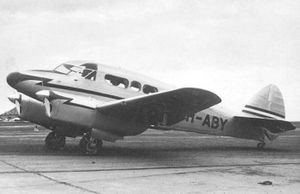Percival Petrel Video - Picture

|
|
Percival Q.6 Petrel

Role: Six-seat military communications aircraft, four- or six-seat civil feederliner
Manufacturer: Percival Aircraft Ltd
Designer: Edgar Percival
First flight: 14 September 1937
Introduction: 1938
Status: Retired
Primary users: Royal Air Force
Fleet Air Arm
Lithuania
Egypt
Number built: 27
The Percival Q.6 Petrel was a 1930s British communications aircraft built by Percival Aircraft Limited at Luton. It was used during the Second World War by the Royal Air Force and Royal Navy as a communications and liaison aircraft. It was a twin-engine, low-wing monoplane with a tailwheel undercarriage.
Design and development
The Percival Type-Q was Percival's first twin-engine aircraft. It was constructed of wood, with plywood and fabric covering. It had a fixed, tailwheel undercarriage, with faired mainwheels, although four of the production machines would be equipped with retractable undercarriage.
Two versions were designed: the Q.4, a four-seat executive transport, and the Q.6, a six-seat feederliner. The Q.4 was not built. The prototype Q.6, registration G-AEYE, first flew on 14 September 1937 at Luton. Production started in 1938, and the first production aircraft, registered G-AFFD, was delivered to Sir Philip Sassoon on 2 March 1938.
Operational history
A small number were exported, including one to the King Ghazi I of Iraq, two to the Lithuanian Ministry of Communications, one to the Australian Civil Aviation Board and two to the Egyptian government in military camouflage. A total of 27 aircraft were built (one prototype and 26 production aircraft).
The Royal Air Force bought seven aircraft for communications duties under Air Ministry Specification 25/38; these were named Petrel. The Egyptian government bought 2 Q.6s.
In the early months of the Second World War, most of the civil Q.6s were requisitioned for service with the RAF and RN. Two Q.6s of the Lithuanian National Airline were impressed by the Soviet Air Forces in 1940.
With one exception, all the civilian Q.6s served with the Royal Air Force during the Second World War. Between 1946 and 1947, four requisitioned Q.6s and three Petrels were sold to civilian buyers.
Variants
Q.4
Four-seat civil executive transport, none built.
Q.6
Six-seat civil feederliner.
Petrel
Six-seat military communications aircraft, 7 built.
Operators
Civilian operators
Australia Egypt
Government of Egypt
France British India Iraq Lithuania
Lithuanian National Airline
United Kingdom
Starways
Western Airways
The aircraft was also operated by flying clubs, companies and private individuals.
Military operators
Egypt
Royal Egyptian Air Force
Soviet Union
Soviet Air Force operated captured Lithuanian aircraft.
United Kingdom
Royal Air Force
No. 24 Squadron RAF
No. 173 Squadron RAF
No. 267 Squadron RAF
No. 510 Squadron RAF
Fleet Air Arm
Survivors
One Q.6, the first production registered G-AFFD, is still current on the United Kingdom Civil Aircraft Register but with an expired certificate of airworthiness. Currently being stored at Seething Airfield, Norwich, Norfolk.
Specifications (Percival Petrel)
Data from The Hamlyn Concise Guide to British Aircraft of World War II
General characteristics
Crew: 2
Capacity: 4/6
Length: 32 ft 3 in (9.83 m)
Wingspan: 46 ft 8 in (14.22 m)
Height: 9 ft 9 in (2.97 m)
Wing area: 278 ft² (25.83 m²)
Empty weight: 3,500 lb (1,588 kg)
Loaded weight: lb (kg)
Useful load: lb (kg)
Max takeoff weight: 5,500 lb (2,495 kg)
Powerplant: 2 x— de Havilland Gipsy Six inline 2-blade, 205 hp (153 kW) each
Performance
Never exceed speed: knots (mph, km/h)
Maximum speed: 195 mph (314 km/h)
Cruise speed: 175 mph (282 km/h)
Stall speed: knots (mph, km/h)
Range: 750 mi (1,207 km)
Service ceiling: 21,000 ft (6,400 m)
Rate of climb: ft/min (m/s)
Wing loading: lb/ft² (kg/m²)
Power/mass: hp/lb (W/kg)
Armament
none
Comparable aircraft
Airspeed Envoy
Bibliography
Ellis, Ken. Wrecks & Relics. Hinkley, UK: Midland Publishing, 2006. ISBN 1-85780-235-7.
The Illustrated Encyclopedia of Aircraft (Part Work 1982-1985). London: Orbis Publishing, 1985.
Jackson, A.J. British Civil Aircraft Since 1919, Volume 3. London: Putnam, 1974. ISBN 0-700-10014-X.
Percival Petrel Pictures
More airplane video.
Source: WikiPedia